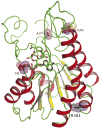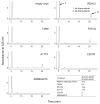Novel RDH12 mutations associated with Leber congenital amaurosis and cone-rod dystrophy: biochemical and clinical evaluations
- PMID: 17512964
- PMCID: PMC2441904
- DOI: 10.1016/j.visres.2007.04.005
Novel RDH12 mutations associated with Leber congenital amaurosis and cone-rod dystrophy: biochemical and clinical evaluations
Abstract
The purpose of this study was to determine the role of the retinol dehydrogenase 12 (RDH12) gene in patients affected with Leber congenital amaurosis (LCA), autosomal recessive retinitis pigmentosa (arRP) and autosomal dominant/recessive cone-rod dystrophies (CORD). Changes in the promoter region, coding regions and exon/intron junctions of the RDH12 gene were evaluated using direct DNA sequencing of patients affected with LCA (n=36 cases), RP (n=62) and CORD (n=21). The allele frequency of changes observed was assessed in a multiethnic control population (n=159 individuals). Detailed biochemical and structural modeling analysis of the observed mutations were performed to assess their biological role in the inactivation of Rdh12. A comprehensive clinical assessment of retinal structure and function in LCA patients carrying mutations in the RDH12 gene was completed. Of the six changes identified, three were novel including a homozygous C201R change in a patient affected with LCA, a heterozygous A177V change in patients affected with CORD and a heterozygous G46G change in a patient affected with LCA. A novel compound heterozygote T49M/A269fsX270 mutation was also found in a patient with LCA, and both homozygous and heterozygous R161Q changes were seen in 26 patients affected with LCA, CORD or RP. These R161Q, G46G and the A177V sequence changes were shown to be polymorphic. We found that Rdh12 mutant proteins associated with LCA were inactive or displayed only residual activity when expressed in COS-7 and Sf9 cells, whereas those mutants that were considered polymorphisms were fully active. Thus, impairment of retinal structure and function for patients carrying these mutations correlated with the biochemical properties of the mutants.
Figures







Similar articles
-
Retinal dehydrogenase 12 (RDH12) mutations in leber congenital amaurosis.Am J Hum Genet. 2004 Oct;75(4):639-46. doi: 10.1086/424889. Epub 2004 Aug 20. Am J Hum Genet. 2004. PMID: 15322982 Free PMC article.
-
Retinal degeneration associated with RDH12 mutations results from decreased 11-cis retinal synthesis due to disruption of the visual cycle.Hum Mol Genet. 2005 Dec 15;14(24):3865-75. doi: 10.1093/hmg/ddi411. Epub 2005 Nov 3. Hum Mol Genet. 2005. PMID: 16269441
-
Exome sequencing identifies RDH12 compound heterozygous mutations in a family with severe retinitis pigmentosa.Gene. 2013 Oct 10;528(2):178-82. doi: 10.1016/j.gene.2013.07.021. Epub 2013 Jul 27. Gene. 2013. PMID: 23900199
-
Phenotyping and genotyping inherited retinal diseases: Molecular genetics, clinical and imaging features, and therapeutics of macular dystrophies, cone and cone-rod dystrophies, rod-cone dystrophies, Leber congenital amaurosis, and cone dysfunction syndromes.Prog Retin Eye Res. 2024 May;100:101244. doi: 10.1016/j.preteyeres.2024.101244. Epub 2024 Jan 24. Prog Retin Eye Res. 2024. PMID: 38278208 Review.
-
[From gene to disease; Leber congenital amaurosis (LCA)].Ned Tijdschr Geneeskd. 2005 Oct 15;149(42):2334-7. Ned Tijdschr Geneeskd. 2005. PMID: 16261712 Review. Dutch.
Cited by
-
Expanding the phenotypic spectrum in RDH12-associated retinal disease.Cold Spring Harb Mol Case Stud. 2020 Feb 3;6(1):a004754. doi: 10.1101/mcs.a004754. Print 2020 Feb. Cold Spring Harb Mol Case Stud. 2020. PMID: 32014858 Free PMC article.
-
Retinal morphology in patients with BBS1 and BBS10 related Bardet-Biedl Syndrome evaluated by Fourier-domain optical coherence tomography.Vision Res. 2008 Feb;48(3):392-9. doi: 10.1016/j.visres.2007.08.024. Epub 2007 Nov 5. Vision Res. 2008. PMID: 17980398 Free PMC article.
-
Natural History and Genotype-Phenotype Correlations in RDH12-Associated Retinal Degeneration.Adv Exp Med Biol. 2019;1185:209-213. doi: 10.1007/978-3-030-27378-1_34. Adv Exp Med Biol. 2019. PMID: 31884613 Free PMC article. Review.
-
Longitudinal clinical course of three Japanese patients with Leber congenital amaurosis/early-onset retinal dystrophy with RDH12 mutation.Doc Ophthalmol. 2014 Jun;128(3):219-28. doi: 10.1007/s10633-014-9436-z. Epub 2014 Apr 22. Doc Ophthalmol. 2014. PMID: 24752437
-
Conditional Ablation of Retinol Dehydrogenase 10 in the Retinal Pigmented Epithelium Causes Delayed Dark Adaption in Mice.J Biol Chem. 2015 Nov 6;290(45):27239-27247. doi: 10.1074/jbc.M115.682096. Epub 2015 Sep 21. J Biol Chem. 2015. PMID: 26391396 Free PMC article.
References
-
- Acland GM, Aguirre GD, Ray J, Zhang Q, Aleman TS, Cideciyan AV, et al. Gene therapy restores vision in a canine model of childhood blindness. Nature Genetics. 2001;28(1):92–95. - PubMed
-
- Aleman TS, Jacobson SG, Chico JD, Scott ML, Cheung AY, Windsor EA, et al. Impairment of the transient pupillary light reflex in Rpe65(−/−) mice and humans with leber congenital amaurosis. Investigative Ophthalmology and Visual Science. 2004;45(4):1259–1271. - PubMed
-
- Belyaeva OV, Korkina OV, Stetsenko AV, Kim T, Nelson PS, Kedishvili NY. Biochemical properties of purified human retinol dehydrogenase 12 (RDH12): Catalytic efficiency toward retinoids and C9 aldehydes and effects of cellular retinol-binding protein type I (CRBPI) and cellular retinaldehyde-binding protein (CRALBP) on the oxidation and reduction of retinoids. Biochemistry. 2005;44(18):7035–7047. - PMC - PubMed
Publication types
MeSH terms
Substances
Grants and funding
LinkOut - more resources
Full Text Sources
Other Literature Sources
Research Materials

